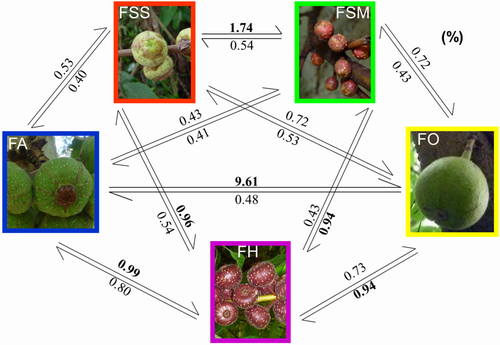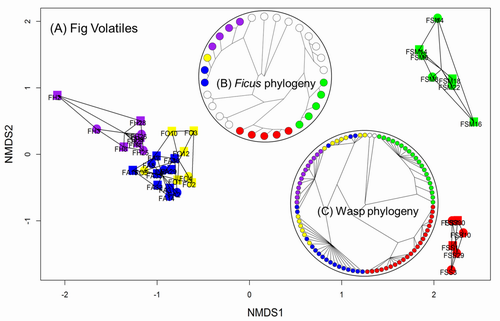英国皇家学会期刊:中科院版纳植物园陈进研究组揭示榕树-榕小
近日,最新一期的国际学术期刊英国皇家学会期刊《Proceedings of the Royal Society B》杂志上在线发表了中国科学院版纳植物园动植物关系研究组陈进研究员与美国Morton树木园科技人员合作的一篇题为Pollinator sharing and gene flow among closely related sympatric dioecious fig taxa的研究论文,王刚博士为论文第一作者。
榕树与其传粉小蜂一对一关系被作为一模式系统,用以研究动植物如何通过协同进化,促进双方的物种分化与多样性共存。然而,中国科学院西双版纳热带植物园动植物关系研究组新的研究表明,榕小蜂并没有想象的那样专一,同域分布的榕树种间杂交和种间基因交流非常普遍,研究结果以在线发表在 上。
版纳植物园动植物关系研究组王刚博士在该研究组研究员陈进的指导下,与美国Morton树木园科技人员合作,以东南亚热带地区同域分布的2个组的5种近缘榕树种及其各自传粉榕小蜂为材料,借助分子生物学的手段调查了同域近缘榕树传粉者共享和种间基因交流的格局,同时运用化学生态学和昆虫行为学的方法检测其背后的可能原因。研究结果发现:1)5种榕树上都存在一定程度的传粉者共享,同组或异组的榕树种间都存在可检测到的基因交流;2)每种榕树的挥发物都可以吸引至少2种传粉榕小蜂;3)榕树种间挥发物组成越相似,其传粉者共享水平和种间基因交流水平也越高。这些结果表明,在榕树-榕小蜂这一迄今已知的最紧密严格的专性传粉系统内,存在着较普遍的传粉者共享和种间基因交流,而花挥发物,这一原来被认为维持专性传粉关系最重要的信号机制,其对多种传粉者的吸引能力很可能正是传粉者共享和种间基因交流产生的原因。虽然各类专性传粉系统都具有自己一定的特点,但是各系统内同域分布植物都主要依靠花挥发物对特定传粉者的吸引来维持所谓“专性传粉关系”和传粉者介导的生殖隔离。因此该研究结果可能也同样适用于其它专性传粉系统。在这些专性传粉系统中,传粉者共享和种间基因交流对于系统内高度物种多样性形成的贡献值得进一步研究。

图1:五种近缘榕树种间均检测到一定程度的基因交流

图2:近缘榕树种间花挥发物更相似且对应更高的传粉者共享水平
原文链接:
Pollinator sharing and GENE flow among closely related sympatric dioecious fig taxa
原文摘要:
Hybridization and insect pollination are widely believed to increase rates of plant diversification. The extreme diversity of figs (Ficus) and their obligate pollinators, fig wasps (Agaonidae), provides an opportunity to examine the possible role of pollinator-mediated hybridization in plant diversification. Increasing evidence suggests that pollinator sharing and hybridization occurs among fig taxa, despite relatively strict coevolution with the pollinating wasp. Using five sympatric dioecious fig taxa and their pollinators, we examine the degree of pollinator sharing and inter-taxa gene flow. We experimentally test pollinator preference for floral volatiles, the main host recognition signal, from different figs. All five fig taxa shared pollinators with other taxa, and gene flow occurred between fig taxa within and between sections. Floral volatiles of each taxon attracted more than one pollinator species. Floral volatiles were more similar between closely related figs, which experienced higher levels of pollinator sharing and inter-taxa gene flow. This study demonstrates that pollinator sharing and inter-taxa gene flow occurs among closely related sympatric dioecious fig taxa and that pollinators choose the floral volatiles of multiple fig taxa. The implications of pollinator sharing and inter-taxa gene flow on diversification, occurring even in this highly specialized obligate pollination system, require further study.
作者:陈进

